BUS 570: Annotated Outline and Bibliography on IoT Devices
VerifiedAdded on 2022/08/12
|15
|3780
|34
Homework Assignment
AI Summary
This assignment presents an annotated outline and bibliography focused on the implementation of IoT smart devices in homes. It begins with an abstract and introduction, defining the concept of IoT smart devices and exploring relevant market trends. The paper delves into the challenges associated with integrating these devices into homes, including privacy, security, and device-related issues. Ethical considerations are also examined, particularly concerning data usage and security. Furthermore, the assignment addresses the potential risks and costs associated with IoT smart devices, including intrusion detection and energy management. It concludes by proposing the use of an enhanced security framework to protect the underlying devices within the IoT framework. The assignment is based on the BUS 570 course and follows APA 7th edition guidelines. It includes references to academic sources like journals, following the provided assignment brief.
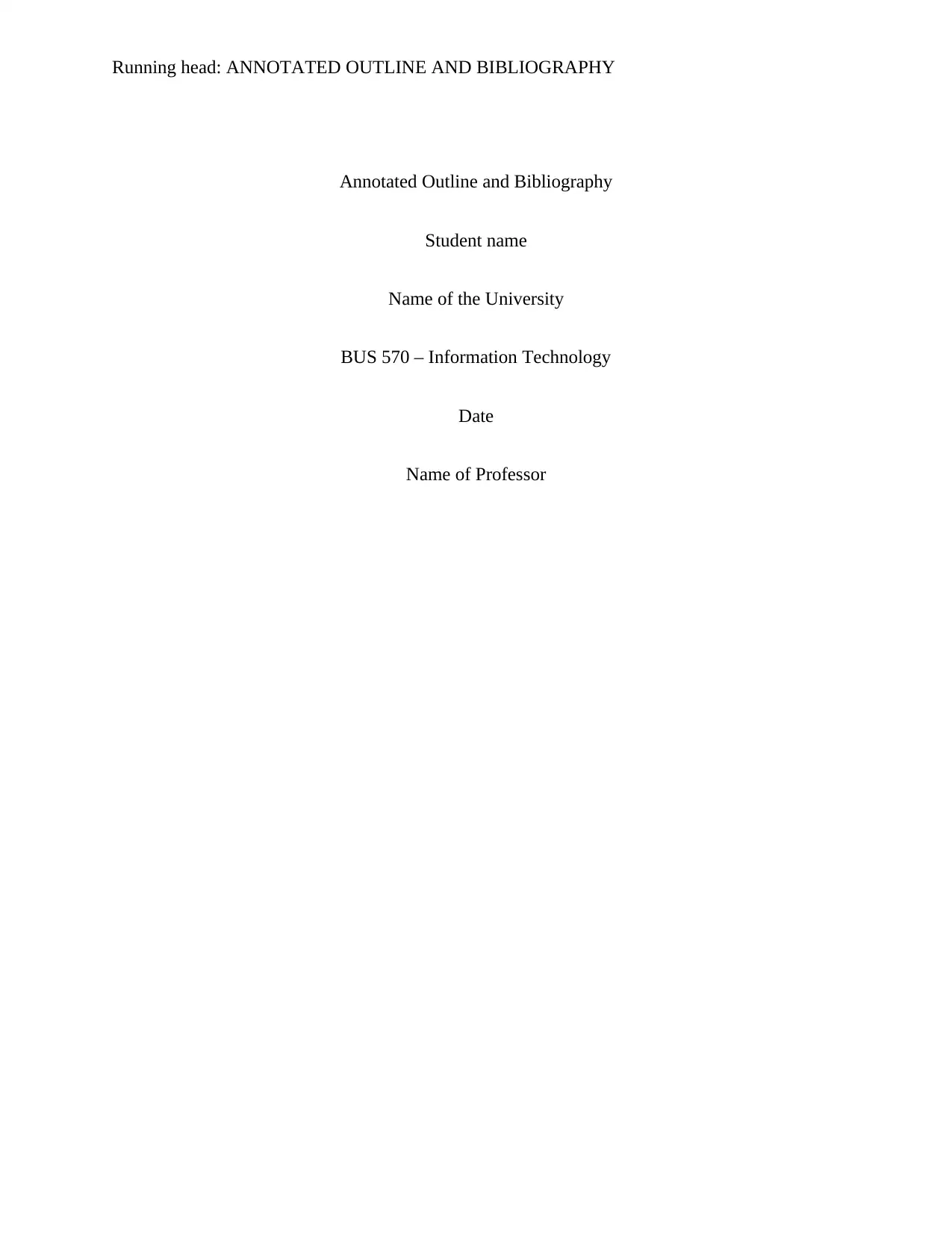
Running head: ANNOTATED OUTLINE AND BIBLIOGRAPHY
Annotated Outline and Bibliography
Student name
Name of the University
BUS 570 – Information Technology
Date
Name of Professor
Annotated Outline and Bibliography
Student name
Name of the University
BUS 570 – Information Technology
Date
Name of Professor
Paraphrase This Document
Need a fresh take? Get an instant paraphrase of this document with our AI Paraphraser
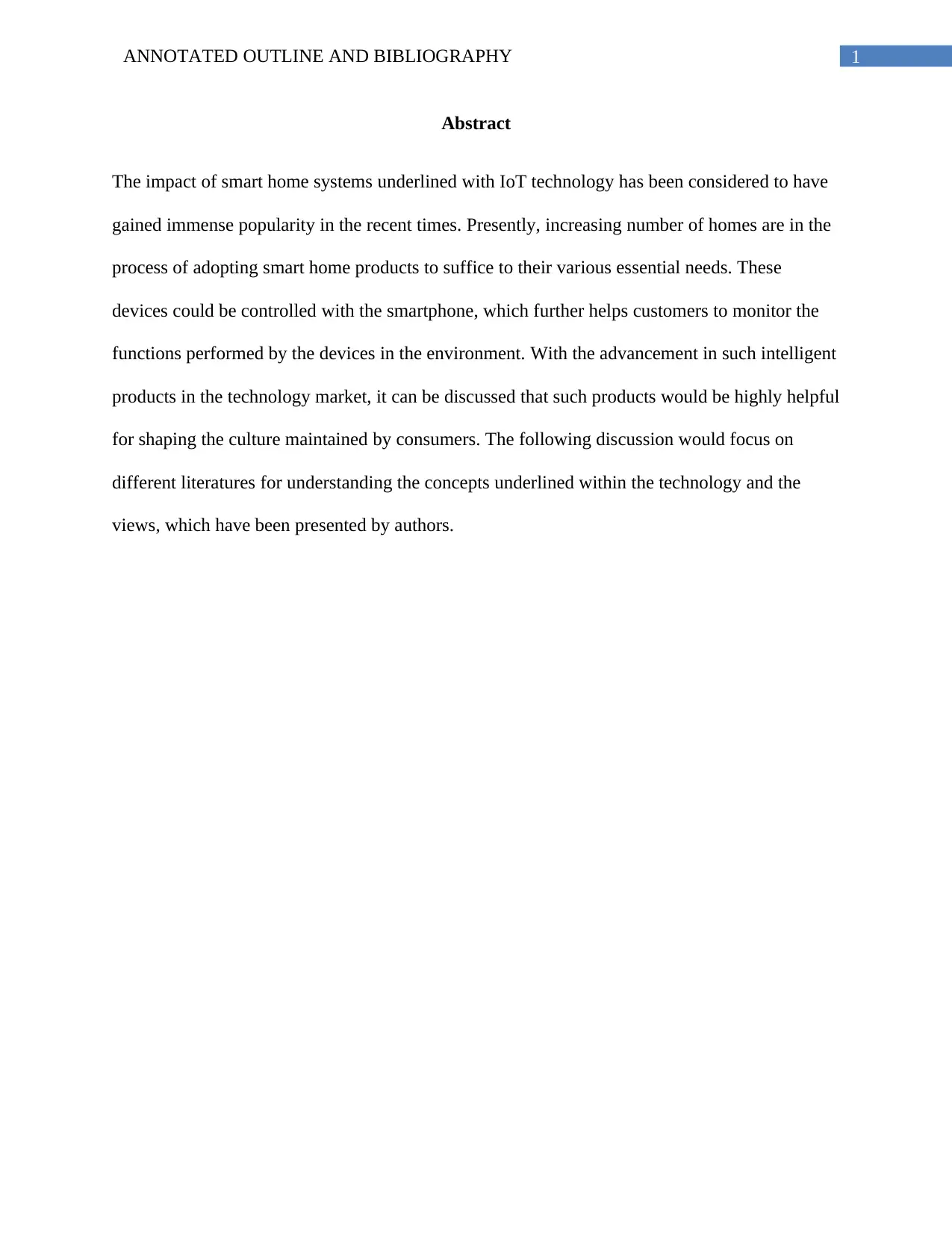
1ANNOTATED OUTLINE AND BIBLIOGRAPHY
Abstract
The impact of smart home systems underlined with IoT technology has been considered to have
gained immense popularity in the recent times. Presently, increasing number of homes are in the
process of adopting smart home products to suffice to their various essential needs. These
devices could be controlled with the smartphone, which further helps customers to monitor the
functions performed by the devices in the environment. With the advancement in such intelligent
products in the technology market, it can be discussed that such products would be highly helpful
for shaping the culture maintained by consumers. The following discussion would focus on
different literatures for understanding the concepts underlined within the technology and the
views, which have been presented by authors.
Abstract
The impact of smart home systems underlined with IoT technology has been considered to have
gained immense popularity in the recent times. Presently, increasing number of homes are in the
process of adopting smart home products to suffice to their various essential needs. These
devices could be controlled with the smartphone, which further helps customers to monitor the
functions performed by the devices in the environment. With the advancement in such intelligent
products in the technology market, it can be discussed that such products would be highly helpful
for shaping the culture maintained by consumers. The following discussion would focus on
different literatures for understanding the concepts underlined within the technology and the
views, which have been presented by authors.
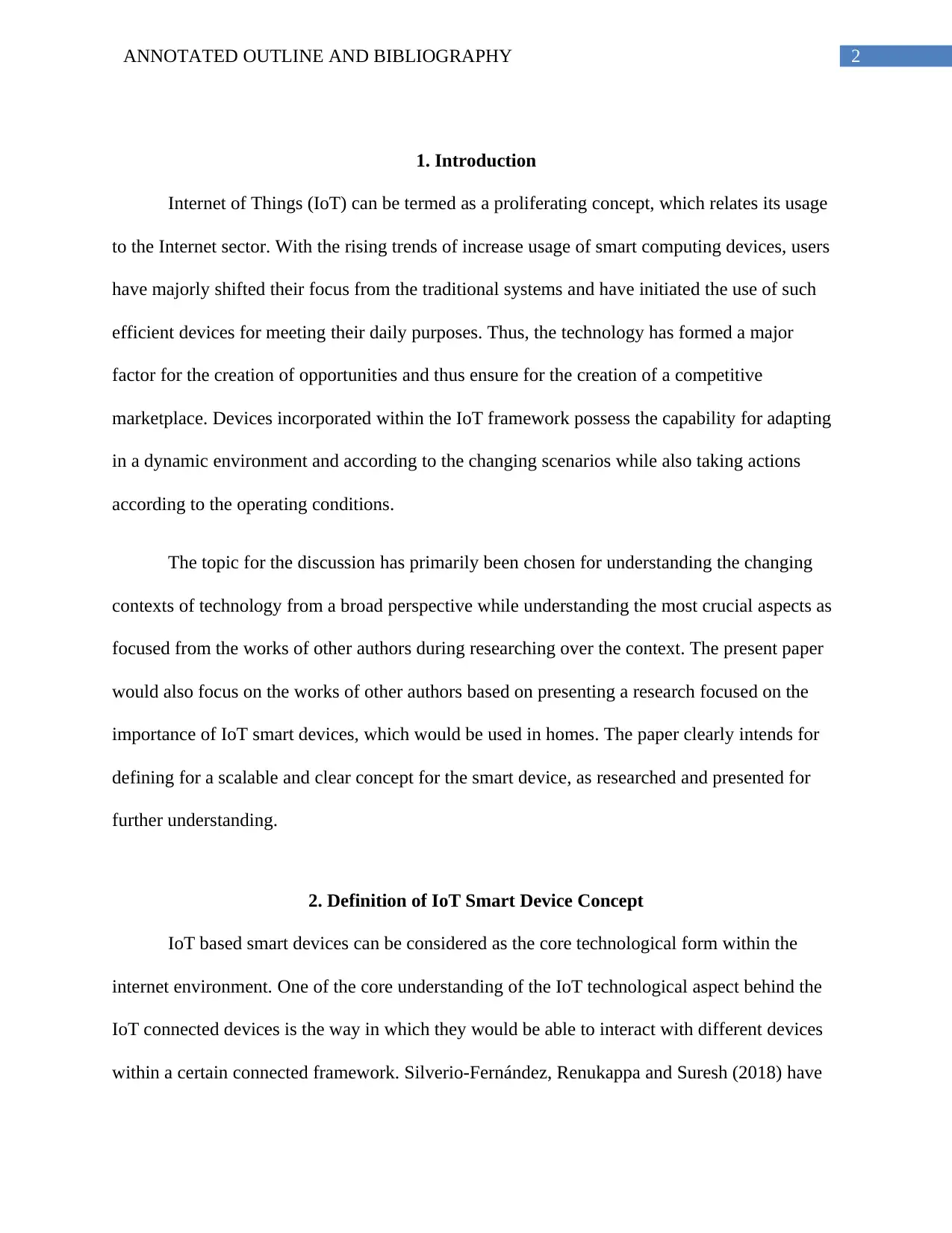
2ANNOTATED OUTLINE AND BIBLIOGRAPHY
1. Introduction
Internet of Things (IoT) can be termed as a proliferating concept, which relates its usage
to the Internet sector. With the rising trends of increase usage of smart computing devices, users
have majorly shifted their focus from the traditional systems and have initiated the use of such
efficient devices for meeting their daily purposes. Thus, the technology has formed a major
factor for the creation of opportunities and thus ensure for the creation of a competitive
marketplace. Devices incorporated within the IoT framework possess the capability for adapting
in a dynamic environment and according to the changing scenarios while also taking actions
according to the operating conditions.
The topic for the discussion has primarily been chosen for understanding the changing
contexts of technology from a broad perspective while understanding the most crucial aspects as
focused from the works of other authors during researching over the context. The present paper
would also focus on the works of other authors based on presenting a research focused on the
importance of IoT smart devices, which would be used in homes. The paper clearly intends for
defining for a scalable and clear concept for the smart device, as researched and presented for
further understanding.
2. Definition of IoT Smart Device Concept
IoT based smart devices can be considered as the core technological form within the
internet environment. One of the core understanding of the IoT technological aspect behind the
IoT connected devices is the way in which they would be able to interact with different devices
within a certain connected framework. Silverio-Fernández, Renukappa and Suresh (2018) have
1. Introduction
Internet of Things (IoT) can be termed as a proliferating concept, which relates its usage
to the Internet sector. With the rising trends of increase usage of smart computing devices, users
have majorly shifted their focus from the traditional systems and have initiated the use of such
efficient devices for meeting their daily purposes. Thus, the technology has formed a major
factor for the creation of opportunities and thus ensure for the creation of a competitive
marketplace. Devices incorporated within the IoT framework possess the capability for adapting
in a dynamic environment and according to the changing scenarios while also taking actions
according to the operating conditions.
The topic for the discussion has primarily been chosen for understanding the changing
contexts of technology from a broad perspective while understanding the most crucial aspects as
focused from the works of other authors during researching over the context. The present paper
would also focus on the works of other authors based on presenting a research focused on the
importance of IoT smart devices, which would be used in homes. The paper clearly intends for
defining for a scalable and clear concept for the smart device, as researched and presented for
further understanding.
2. Definition of IoT Smart Device Concept
IoT based smart devices can be considered as the core technological form within the
internet environment. One of the core understanding of the IoT technological aspect behind the
IoT connected devices is the way in which they would be able to interact with different devices
within a certain connected framework. Silverio-Fernández, Renukappa and Suresh (2018) have
⊘ This is a preview!⊘
Do you want full access?
Subscribe today to unlock all pages.

Trusted by 1+ million students worldwide
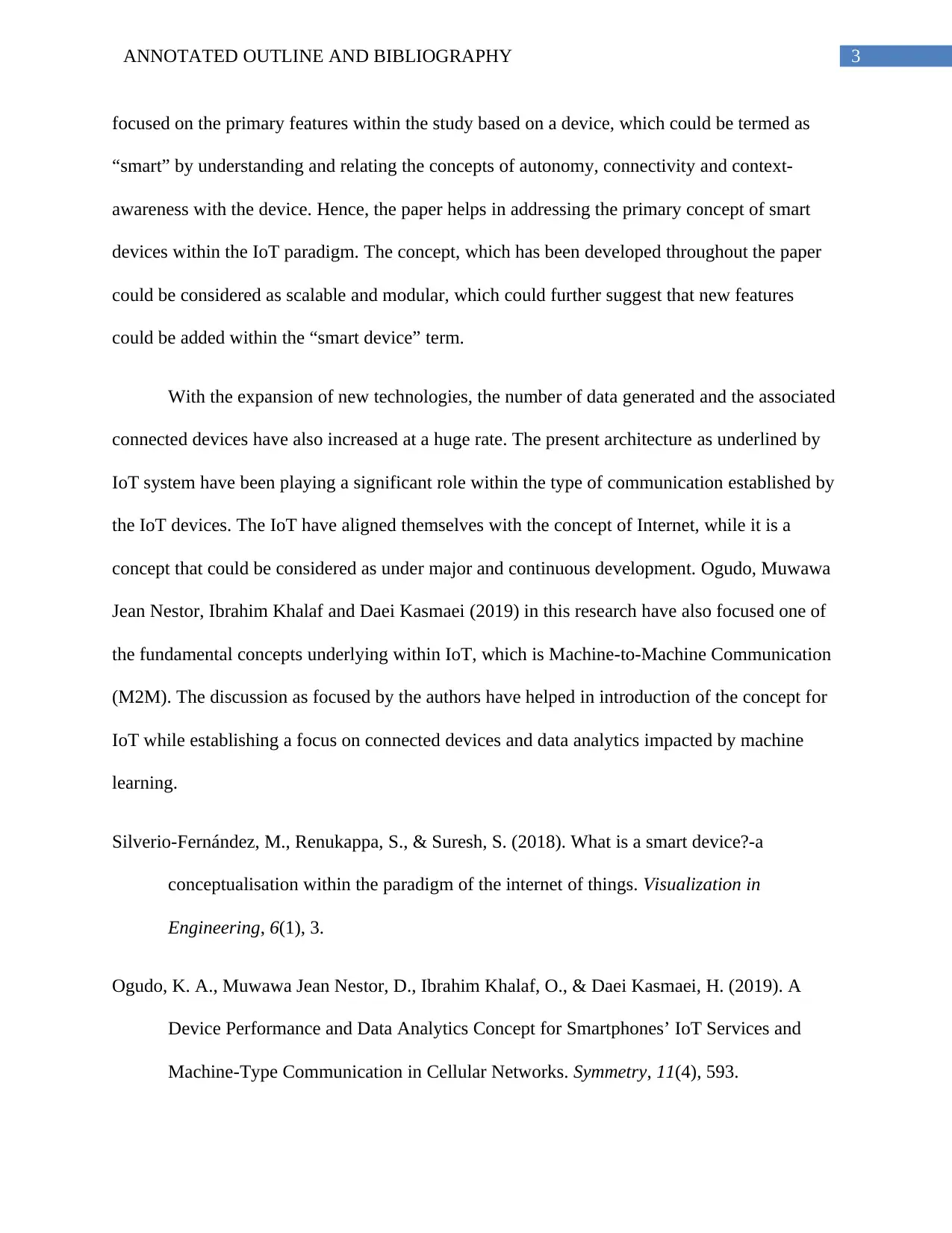
3ANNOTATED OUTLINE AND BIBLIOGRAPHY
focused on the primary features within the study based on a device, which could be termed as
“smart” by understanding and relating the concepts of autonomy, connectivity and context-
awareness with the device. Hence, the paper helps in addressing the primary concept of smart
devices within the IoT paradigm. The concept, which has been developed throughout the paper
could be considered as scalable and modular, which could further suggest that new features
could be added within the “smart device” term.
With the expansion of new technologies, the number of data generated and the associated
connected devices have also increased at a huge rate. The present architecture as underlined by
IoT system have been playing a significant role within the type of communication established by
the IoT devices. The IoT have aligned themselves with the concept of Internet, while it is a
concept that could be considered as under major and continuous development. Ogudo, Muwawa
Jean Nestor, Ibrahim Khalaf and Daei Kasmaei (2019) in this research have also focused one of
the fundamental concepts underlying within IoT, which is Machine-to-Machine Communication
(M2M). The discussion as focused by the authors have helped in introduction of the concept for
IoT while establishing a focus on connected devices and data analytics impacted by machine
learning.
Silverio-Fernández, M., Renukappa, S., & Suresh, S. (2018). What is a smart device?-a
conceptualisation within the paradigm of the internet of things. Visualization in
Engineering, 6(1), 3.
Ogudo, K. A., Muwawa Jean Nestor, D., Ibrahim Khalaf, O., & Daei Kasmaei, H. (2019). A
Device Performance and Data Analytics Concept for Smartphones’ IoT Services and
Machine-Type Communication in Cellular Networks. Symmetry, 11(4), 593.
focused on the primary features within the study based on a device, which could be termed as
“smart” by understanding and relating the concepts of autonomy, connectivity and context-
awareness with the device. Hence, the paper helps in addressing the primary concept of smart
devices within the IoT paradigm. The concept, which has been developed throughout the paper
could be considered as scalable and modular, which could further suggest that new features
could be added within the “smart device” term.
With the expansion of new technologies, the number of data generated and the associated
connected devices have also increased at a huge rate. The present architecture as underlined by
IoT system have been playing a significant role within the type of communication established by
the IoT devices. The IoT have aligned themselves with the concept of Internet, while it is a
concept that could be considered as under major and continuous development. Ogudo, Muwawa
Jean Nestor, Ibrahim Khalaf and Daei Kasmaei (2019) in this research have also focused one of
the fundamental concepts underlying within IoT, which is Machine-to-Machine Communication
(M2M). The discussion as focused by the authors have helped in introduction of the concept for
IoT while establishing a focus on connected devices and data analytics impacted by machine
learning.
Silverio-Fernández, M., Renukappa, S., & Suresh, S. (2018). What is a smart device?-a
conceptualisation within the paradigm of the internet of things. Visualization in
Engineering, 6(1), 3.
Ogudo, K. A., Muwawa Jean Nestor, D., Ibrahim Khalaf, O., & Daei Kasmaei, H. (2019). A
Device Performance and Data Analytics Concept for Smartphones’ IoT Services and
Machine-Type Communication in Cellular Networks. Symmetry, 11(4), 593.
Paraphrase This Document
Need a fresh take? Get an instant paraphrase of this document with our AI Paraphraser
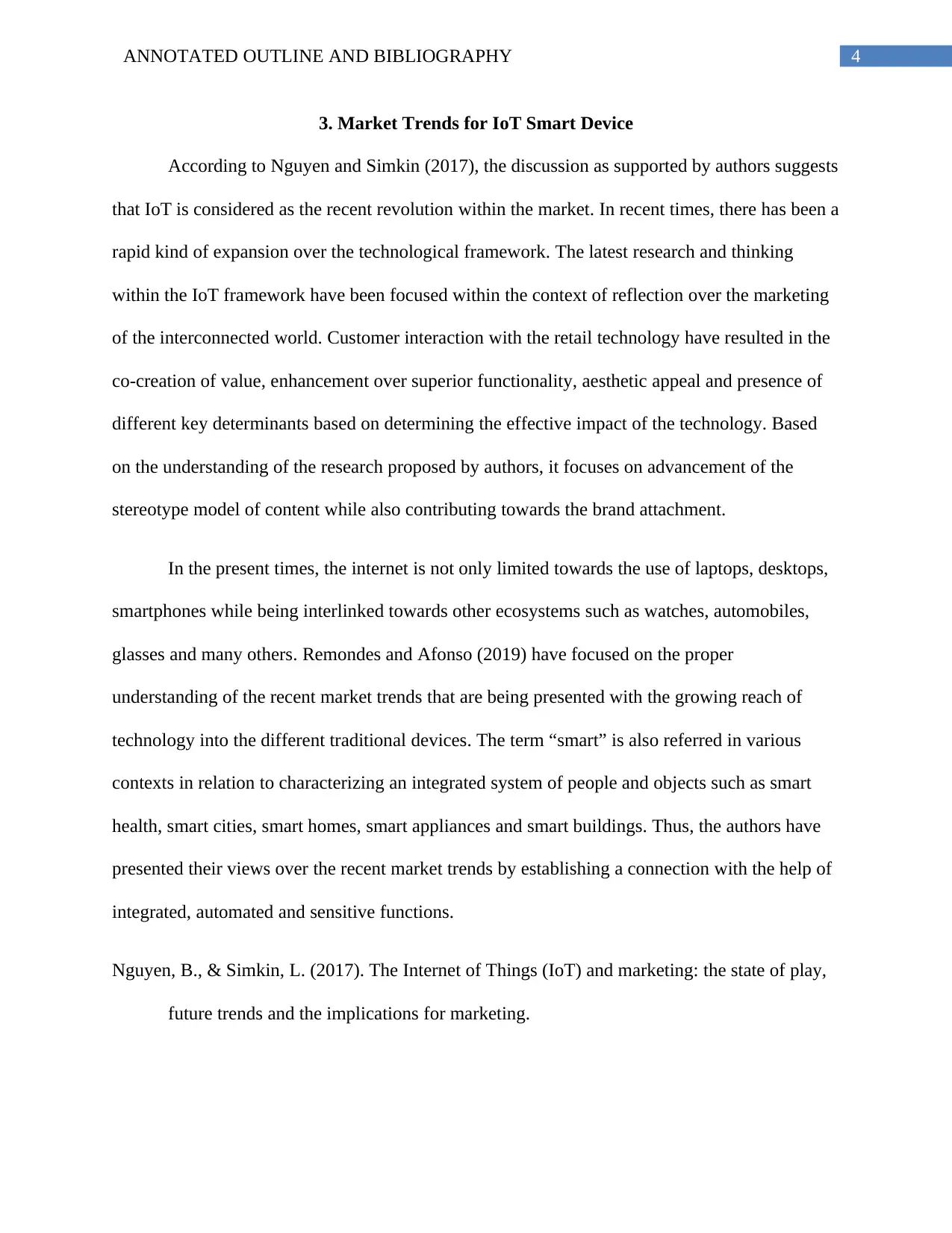
4ANNOTATED OUTLINE AND BIBLIOGRAPHY
3. Market Trends for IoT Smart Device
According to Nguyen and Simkin (2017), the discussion as supported by authors suggests
that IoT is considered as the recent revolution within the market. In recent times, there has been a
rapid kind of expansion over the technological framework. The latest research and thinking
within the IoT framework have been focused within the context of reflection over the marketing
of the interconnected world. Customer interaction with the retail technology have resulted in the
co-creation of value, enhancement over superior functionality, aesthetic appeal and presence of
different key determinants based on determining the effective impact of the technology. Based
on the understanding of the research proposed by authors, it focuses on advancement of the
stereotype model of content while also contributing towards the brand attachment.
In the present times, the internet is not only limited towards the use of laptops, desktops,
smartphones while being interlinked towards other ecosystems such as watches, automobiles,
glasses and many others. Remondes and Afonso (2019) have focused on the proper
understanding of the recent market trends that are being presented with the growing reach of
technology into the different traditional devices. The term “smart” is also referred in various
contexts in relation to characterizing an integrated system of people and objects such as smart
health, smart cities, smart homes, smart appliances and smart buildings. Thus, the authors have
presented their views over the recent market trends by establishing a connection with the help of
integrated, automated and sensitive functions.
Nguyen, B., & Simkin, L. (2017). The Internet of Things (IoT) and marketing: the state of play,
future trends and the implications for marketing.
3. Market Trends for IoT Smart Device
According to Nguyen and Simkin (2017), the discussion as supported by authors suggests
that IoT is considered as the recent revolution within the market. In recent times, there has been a
rapid kind of expansion over the technological framework. The latest research and thinking
within the IoT framework have been focused within the context of reflection over the marketing
of the interconnected world. Customer interaction with the retail technology have resulted in the
co-creation of value, enhancement over superior functionality, aesthetic appeal and presence of
different key determinants based on determining the effective impact of the technology. Based
on the understanding of the research proposed by authors, it focuses on advancement of the
stereotype model of content while also contributing towards the brand attachment.
In the present times, the internet is not only limited towards the use of laptops, desktops,
smartphones while being interlinked towards other ecosystems such as watches, automobiles,
glasses and many others. Remondes and Afonso (2019) have focused on the proper
understanding of the recent market trends that are being presented with the growing reach of
technology into the different traditional devices. The term “smart” is also referred in various
contexts in relation to characterizing an integrated system of people and objects such as smart
health, smart cities, smart homes, smart appliances and smart buildings. Thus, the authors have
presented their views over the recent market trends by establishing a connection with the help of
integrated, automated and sensitive functions.
Nguyen, B., & Simkin, L. (2017). The Internet of Things (IoT) and marketing: the state of play,
future trends and the implications for marketing.

5ANNOTATED OUTLINE AND BIBLIOGRAPHY
Remondes, J., & Afonso, C. (2019). An Overview of Main IoT Trends Applied to Business and
Marketing. In Smart Marketing With the Internet of Things (pp. 245-264). IGI Global.
4. IoT Smart Device in Homes
4.1 Challenges
Stojkoska and Trivodaliev (2017) have discussed the major form of challenges that would
be posed towards the IoT technology, which would be implemented in homes. These challenges
could be presented in terms of privacy, reliability and security of the smart devices, which would
share information between each other in the connected environment. The privacy and security
are considered as the most important issues, which would be faced during establishing a strong
sense of network. The smart grid faces such kind of security challenges from cyber criminals,
which emerges as a critical concern for system designers. Hence, the IoT would require a major
form of security policy based on impacting the homes.
According to Lin and Bergmann (2016), the different presented challenge that would be
mostly faced during the implementation of IoT systems within the homes. Challenges posed over
security and privacy have also been focused by the authors. The different proposed challenges
focused on addressing over the concerns of security. In their discussion over addressing the
security concerns, the authors have focused on the summarizing of the existing network
techniques, which could be primarily used for securing the smart homes and the intact smart
devices, which are effectively used for communicating and controlling the other devices.
Connected homes comprise of sensitive data and several devices such as IP-cameras,
which might be used and activated remotely and could be easily accessible from any part of the
home. Examples of such connected devices would comprise of microphones, which could be
Remondes, J., & Afonso, C. (2019). An Overview of Main IoT Trends Applied to Business and
Marketing. In Smart Marketing With the Internet of Things (pp. 245-264). IGI Global.
4. IoT Smart Device in Homes
4.1 Challenges
Stojkoska and Trivodaliev (2017) have discussed the major form of challenges that would
be posed towards the IoT technology, which would be implemented in homes. These challenges
could be presented in terms of privacy, reliability and security of the smart devices, which would
share information between each other in the connected environment. The privacy and security
are considered as the most important issues, which would be faced during establishing a strong
sense of network. The smart grid faces such kind of security challenges from cyber criminals,
which emerges as a critical concern for system designers. Hence, the IoT would require a major
form of security policy based on impacting the homes.
According to Lin and Bergmann (2016), the different presented challenge that would be
mostly faced during the implementation of IoT systems within the homes. Challenges posed over
security and privacy have also been focused by the authors. The different proposed challenges
focused on addressing over the concerns of security. In their discussion over addressing the
security concerns, the authors have focused on the summarizing of the existing network
techniques, which could be primarily used for securing the smart homes and the intact smart
devices, which are effectively used for communicating and controlling the other devices.
Connected homes comprise of sensitive data and several devices such as IP-cameras,
which might be used and activated remotely and could be easily accessible from any part of the
home. Examples of such connected devices would comprise of microphones, which could be
⊘ This is a preview!⊘
Do you want full access?
Subscribe today to unlock all pages.

Trusted by 1+ million students worldwide
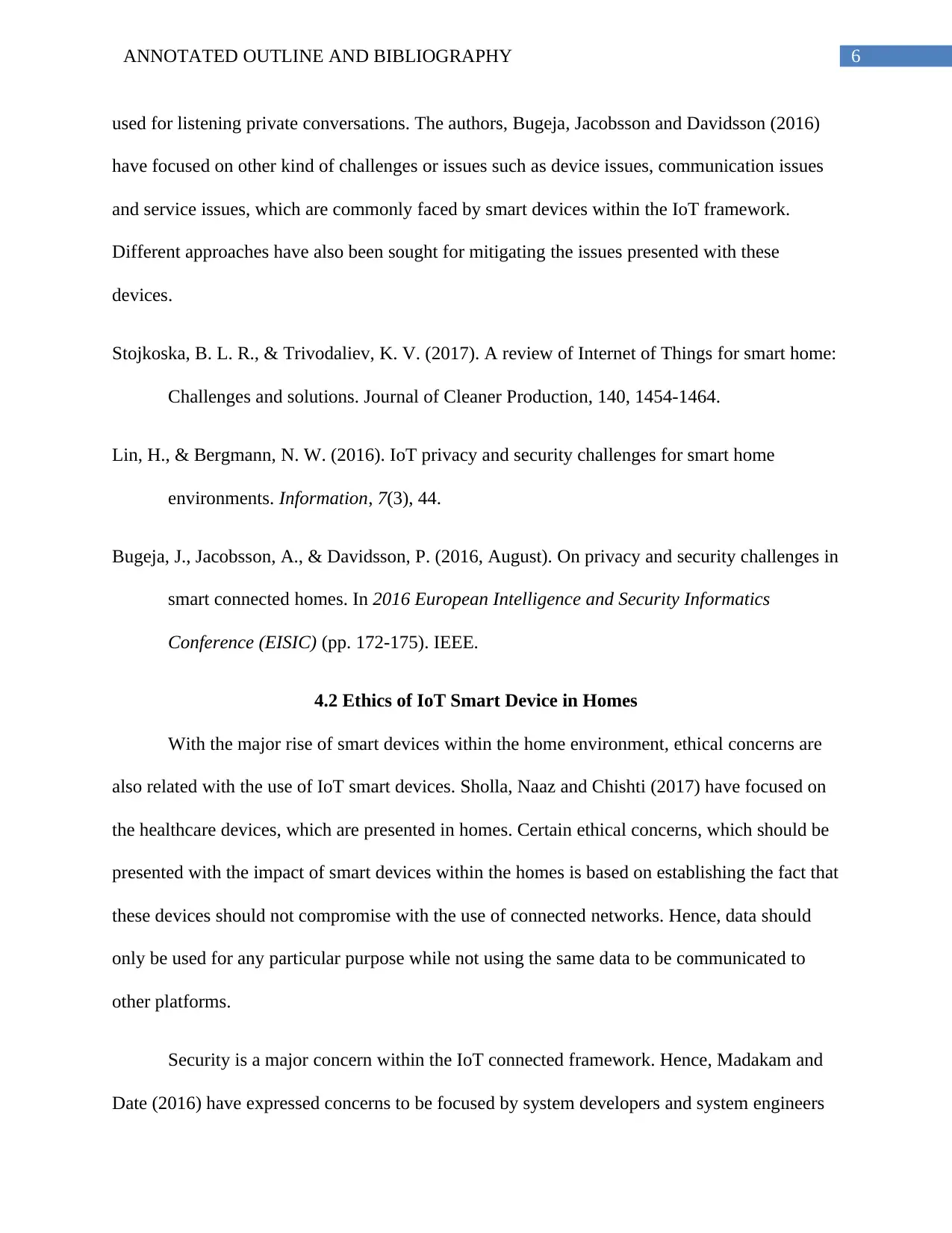
6ANNOTATED OUTLINE AND BIBLIOGRAPHY
used for listening private conversations. The authors, Bugeja, Jacobsson and Davidsson (2016)
have focused on other kind of challenges or issues such as device issues, communication issues
and service issues, which are commonly faced by smart devices within the IoT framework.
Different approaches have also been sought for mitigating the issues presented with these
devices.
Stojkoska, B. L. R., & Trivodaliev, K. V. (2017). A review of Internet of Things for smart home:
Challenges and solutions. Journal of Cleaner Production, 140, 1454-1464.
Lin, H., & Bergmann, N. W. (2016). IoT privacy and security challenges for smart home
environments. Information, 7(3), 44.
Bugeja, J., Jacobsson, A., & Davidsson, P. (2016, August). On privacy and security challenges in
smart connected homes. In 2016 European Intelligence and Security Informatics
Conference (EISIC) (pp. 172-175). IEEE.
4.2 Ethics of IoT Smart Device in Homes
With the major rise of smart devices within the home environment, ethical concerns are
also related with the use of IoT smart devices. Sholla, Naaz and Chishti (2017) have focused on
the healthcare devices, which are presented in homes. Certain ethical concerns, which should be
presented with the impact of smart devices within the homes is based on establishing the fact that
these devices should not compromise with the use of connected networks. Hence, data should
only be used for any particular purpose while not using the same data to be communicated to
other platforms.
Security is a major concern within the IoT connected framework. Hence, Madakam and
Date (2016) have expressed concerns to be focused by system developers and system engineers
used for listening private conversations. The authors, Bugeja, Jacobsson and Davidsson (2016)
have focused on other kind of challenges or issues such as device issues, communication issues
and service issues, which are commonly faced by smart devices within the IoT framework.
Different approaches have also been sought for mitigating the issues presented with these
devices.
Stojkoska, B. L. R., & Trivodaliev, K. V. (2017). A review of Internet of Things for smart home:
Challenges and solutions. Journal of Cleaner Production, 140, 1454-1464.
Lin, H., & Bergmann, N. W. (2016). IoT privacy and security challenges for smart home
environments. Information, 7(3), 44.
Bugeja, J., Jacobsson, A., & Davidsson, P. (2016, August). On privacy and security challenges in
smart connected homes. In 2016 European Intelligence and Security Informatics
Conference (EISIC) (pp. 172-175). IEEE.
4.2 Ethics of IoT Smart Device in Homes
With the major rise of smart devices within the home environment, ethical concerns are
also related with the use of IoT smart devices. Sholla, Naaz and Chishti (2017) have focused on
the healthcare devices, which are presented in homes. Certain ethical concerns, which should be
presented with the impact of smart devices within the homes is based on establishing the fact that
these devices should not compromise with the use of connected networks. Hence, data should
only be used for any particular purpose while not using the same data to be communicated to
other platforms.
Security is a major concern within the IoT connected framework. Hence, Madakam and
Date (2016) have expressed concerns to be focused by system developers and system engineers
Paraphrase This Document
Need a fresh take? Get an instant paraphrase of this document with our AI Paraphraser
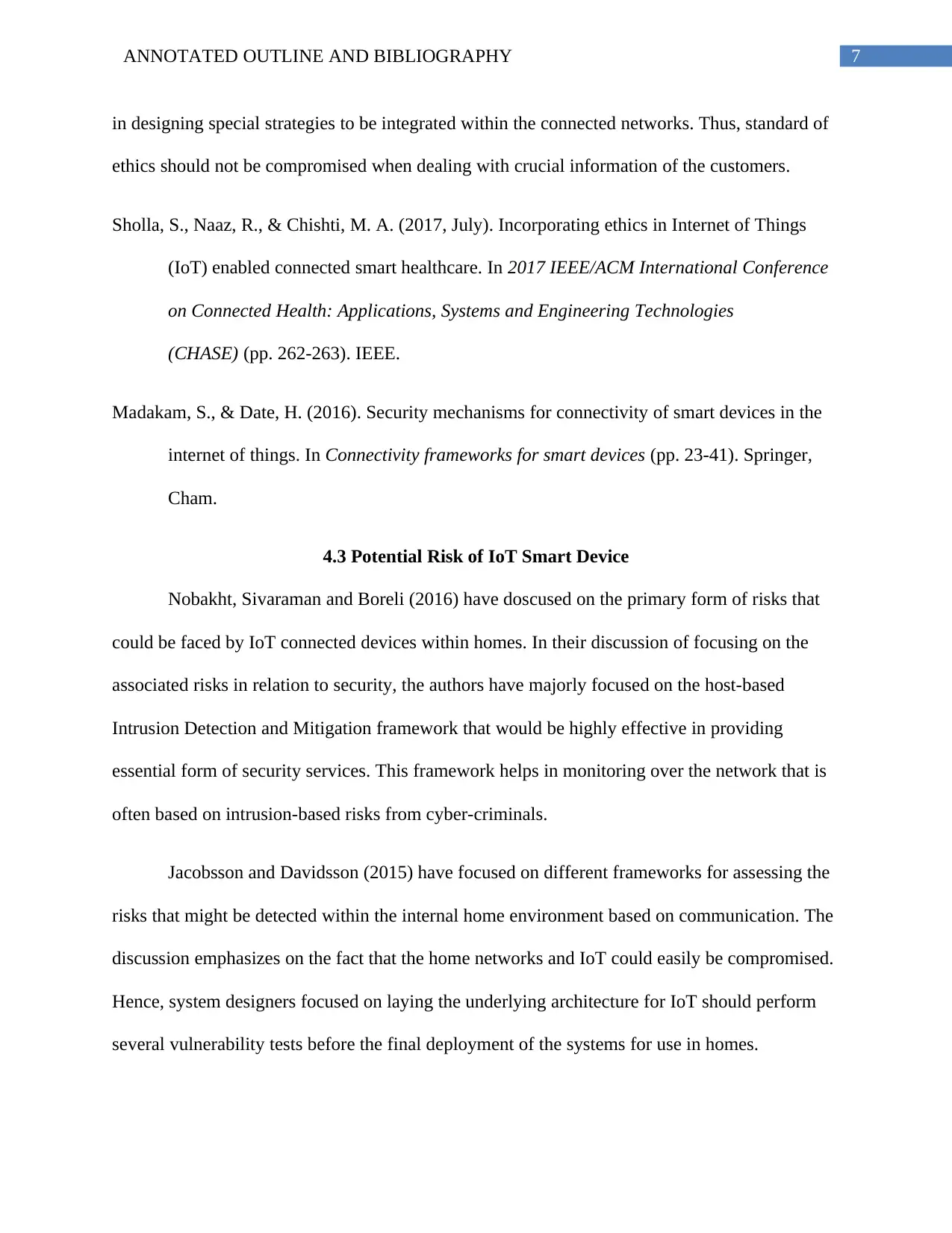
7ANNOTATED OUTLINE AND BIBLIOGRAPHY
in designing special strategies to be integrated within the connected networks. Thus, standard of
ethics should not be compromised when dealing with crucial information of the customers.
Sholla, S., Naaz, R., & Chishti, M. A. (2017, July). Incorporating ethics in Internet of Things
(IoT) enabled connected smart healthcare. In 2017 IEEE/ACM International Conference
on Connected Health: Applications, Systems and Engineering Technologies
(CHASE) (pp. 262-263). IEEE.
Madakam, S., & Date, H. (2016). Security mechanisms for connectivity of smart devices in the
internet of things. In Connectivity frameworks for smart devices (pp. 23-41). Springer,
Cham.
4.3 Potential Risk of IoT Smart Device
Nobakht, Sivaraman and Boreli (2016) have doscused on the primary form of risks that
could be faced by IoT connected devices within homes. In their discussion of focusing on the
associated risks in relation to security, the authors have majorly focused on the host-based
Intrusion Detection and Mitigation framework that would be highly effective in providing
essential form of security services. This framework helps in monitoring over the network that is
often based on intrusion-based risks from cyber-criminals.
Jacobsson and Davidsson (2015) have focused on different frameworks for assessing the
risks that might be detected within the internal home environment based on communication. The
discussion emphasizes on the fact that the home networks and IoT could easily be compromised.
Hence, system designers focused on laying the underlying architecture for IoT should perform
several vulnerability tests before the final deployment of the systems for use in homes.
in designing special strategies to be integrated within the connected networks. Thus, standard of
ethics should not be compromised when dealing with crucial information of the customers.
Sholla, S., Naaz, R., & Chishti, M. A. (2017, July). Incorporating ethics in Internet of Things
(IoT) enabled connected smart healthcare. In 2017 IEEE/ACM International Conference
on Connected Health: Applications, Systems and Engineering Technologies
(CHASE) (pp. 262-263). IEEE.
Madakam, S., & Date, H. (2016). Security mechanisms for connectivity of smart devices in the
internet of things. In Connectivity frameworks for smart devices (pp. 23-41). Springer,
Cham.
4.3 Potential Risk of IoT Smart Device
Nobakht, Sivaraman and Boreli (2016) have doscused on the primary form of risks that
could be faced by IoT connected devices within homes. In their discussion of focusing on the
associated risks in relation to security, the authors have majorly focused on the host-based
Intrusion Detection and Mitigation framework that would be highly effective in providing
essential form of security services. This framework helps in monitoring over the network that is
often based on intrusion-based risks from cyber-criminals.
Jacobsson and Davidsson (2015) have focused on different frameworks for assessing the
risks that might be detected within the internal home environment based on communication. The
discussion emphasizes on the fact that the home networks and IoT could easily be compromised.
Hence, system designers focused on laying the underlying architecture for IoT should perform
several vulnerability tests before the final deployment of the systems for use in homes.
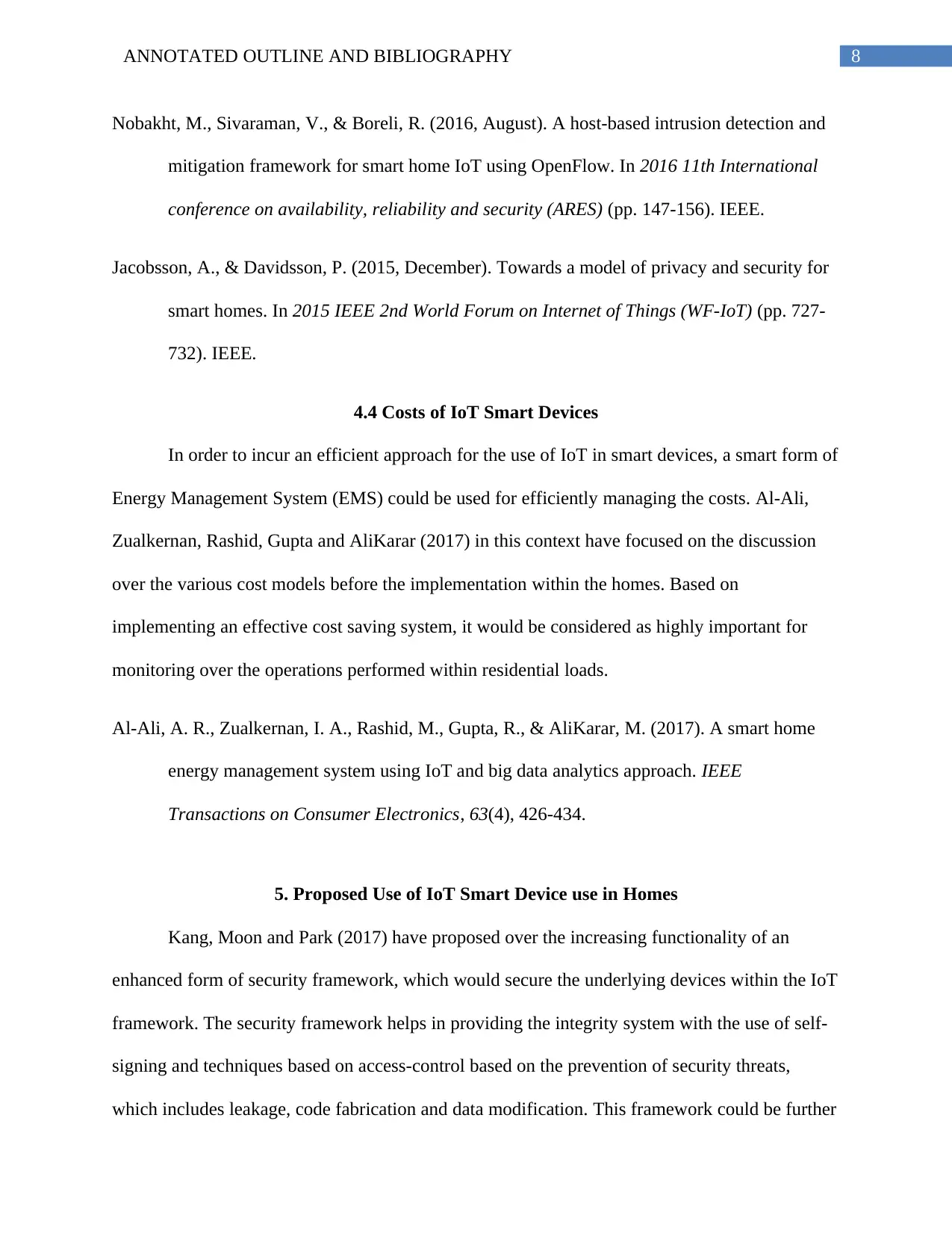
8ANNOTATED OUTLINE AND BIBLIOGRAPHY
Nobakht, M., Sivaraman, V., & Boreli, R. (2016, August). A host-based intrusion detection and
mitigation framework for smart home IoT using OpenFlow. In 2016 11th International
conference on availability, reliability and security (ARES) (pp. 147-156). IEEE.
Jacobsson, A., & Davidsson, P. (2015, December). Towards a model of privacy and security for
smart homes. In 2015 IEEE 2nd World Forum on Internet of Things (WF-IoT) (pp. 727-
732). IEEE.
4.4 Costs of IoT Smart Devices
In order to incur an efficient approach for the use of IoT in smart devices, a smart form of
Energy Management System (EMS) could be used for efficiently managing the costs. Al-Ali,
Zualkernan, Rashid, Gupta and AliKarar (2017) in this context have focused on the discussion
over the various cost models before the implementation within the homes. Based on
implementing an effective cost saving system, it would be considered as highly important for
monitoring over the operations performed within residential loads.
Al-Ali, A. R., Zualkernan, I. A., Rashid, M., Gupta, R., & AliKarar, M. (2017). A smart home
energy management system using IoT and big data analytics approach. IEEE
Transactions on Consumer Electronics, 63(4), 426-434.
5. Proposed Use of IoT Smart Device use in Homes
Kang, Moon and Park (2017) have proposed over the increasing functionality of an
enhanced form of security framework, which would secure the underlying devices within the IoT
framework. The security framework helps in providing the integrity system with the use of self-
signing and techniques based on access-control based on the prevention of security threats,
which includes leakage, code fabrication and data modification. This framework could be further
Nobakht, M., Sivaraman, V., & Boreli, R. (2016, August). A host-based intrusion detection and
mitigation framework for smart home IoT using OpenFlow. In 2016 11th International
conference on availability, reliability and security (ARES) (pp. 147-156). IEEE.
Jacobsson, A., & Davidsson, P. (2015, December). Towards a model of privacy and security for
smart homes. In 2015 IEEE 2nd World Forum on Internet of Things (WF-IoT) (pp. 727-
732). IEEE.
4.4 Costs of IoT Smart Devices
In order to incur an efficient approach for the use of IoT in smart devices, a smart form of
Energy Management System (EMS) could be used for efficiently managing the costs. Al-Ali,
Zualkernan, Rashid, Gupta and AliKarar (2017) in this context have focused on the discussion
over the various cost models before the implementation within the homes. Based on
implementing an effective cost saving system, it would be considered as highly important for
monitoring over the operations performed within residential loads.
Al-Ali, A. R., Zualkernan, I. A., Rashid, M., Gupta, R., & AliKarar, M. (2017). A smart home
energy management system using IoT and big data analytics approach. IEEE
Transactions on Consumer Electronics, 63(4), 426-434.
5. Proposed Use of IoT Smart Device use in Homes
Kang, Moon and Park (2017) have proposed over the increasing functionality of an
enhanced form of security framework, which would secure the underlying devices within the IoT
framework. The security framework helps in providing the integrity system with the use of self-
signing and techniques based on access-control based on the prevention of security threats,
which includes leakage, code fabrication and data modification. This framework could be further
⊘ This is a preview!⊘
Do you want full access?
Subscribe today to unlock all pages.

Trusted by 1+ million students worldwide
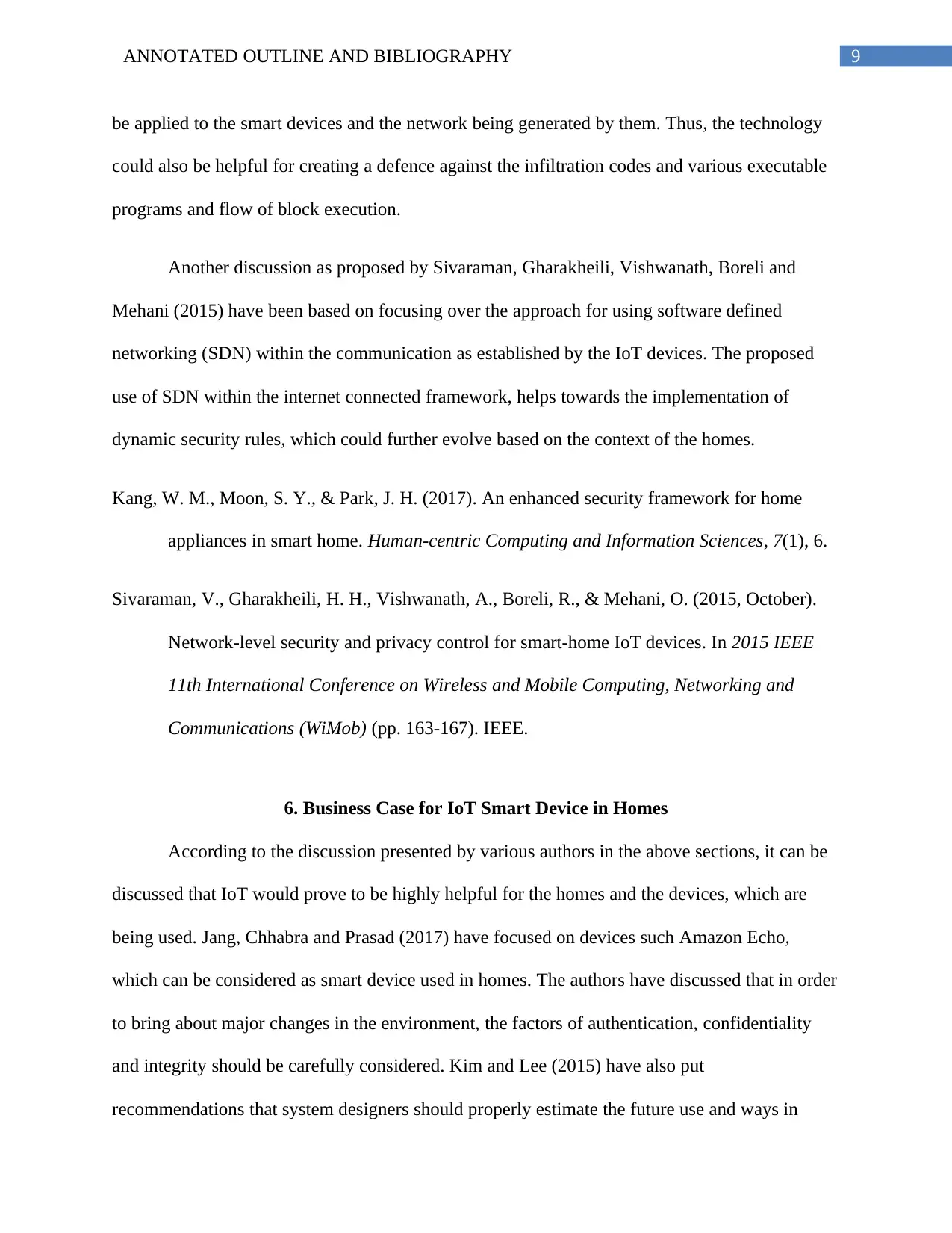
9ANNOTATED OUTLINE AND BIBLIOGRAPHY
be applied to the smart devices and the network being generated by them. Thus, the technology
could also be helpful for creating a defence against the infiltration codes and various executable
programs and flow of block execution.
Another discussion as proposed by Sivaraman, Gharakheili, Vishwanath, Boreli and
Mehani (2015) have been based on focusing over the approach for using software defined
networking (SDN) within the communication as established by the IoT devices. The proposed
use of SDN within the internet connected framework, helps towards the implementation of
dynamic security rules, which could further evolve based on the context of the homes.
Kang, W. M., Moon, S. Y., & Park, J. H. (2017). An enhanced security framework for home
appliances in smart home. Human-centric Computing and Information Sciences, 7(1), 6.
Sivaraman, V., Gharakheili, H. H., Vishwanath, A., Boreli, R., & Mehani, O. (2015, October).
Network-level security and privacy control for smart-home IoT devices. In 2015 IEEE
11th International Conference on Wireless and Mobile Computing, Networking and
Communications (WiMob) (pp. 163-167). IEEE.
6. Business Case for IoT Smart Device in Homes
According to the discussion presented by various authors in the above sections, it can be
discussed that IoT would prove to be highly helpful for the homes and the devices, which are
being used. Jang, Chhabra and Prasad (2017) have focused on devices such Amazon Echo,
which can be considered as smart device used in homes. The authors have discussed that in order
to bring about major changes in the environment, the factors of authentication, confidentiality
and integrity should be carefully considered. Kim and Lee (2015) have also put
recommendations that system designers should properly estimate the future use and ways in
be applied to the smart devices and the network being generated by them. Thus, the technology
could also be helpful for creating a defence against the infiltration codes and various executable
programs and flow of block execution.
Another discussion as proposed by Sivaraman, Gharakheili, Vishwanath, Boreli and
Mehani (2015) have been based on focusing over the approach for using software defined
networking (SDN) within the communication as established by the IoT devices. The proposed
use of SDN within the internet connected framework, helps towards the implementation of
dynamic security rules, which could further evolve based on the context of the homes.
Kang, W. M., Moon, S. Y., & Park, J. H. (2017). An enhanced security framework for home
appliances in smart home. Human-centric Computing and Information Sciences, 7(1), 6.
Sivaraman, V., Gharakheili, H. H., Vishwanath, A., Boreli, R., & Mehani, O. (2015, October).
Network-level security and privacy control for smart-home IoT devices. In 2015 IEEE
11th International Conference on Wireless and Mobile Computing, Networking and
Communications (WiMob) (pp. 163-167). IEEE.
6. Business Case for IoT Smart Device in Homes
According to the discussion presented by various authors in the above sections, it can be
discussed that IoT would prove to be highly helpful for the homes and the devices, which are
being used. Jang, Chhabra and Prasad (2017) have focused on devices such Amazon Echo,
which can be considered as smart device used in homes. The authors have discussed that in order
to bring about major changes in the environment, the factors of authentication, confidentiality
and integrity should be carefully considered. Kim and Lee (2015) have also put
recommendations that system designers should properly estimate the future use and ways in
Paraphrase This Document
Need a fresh take? Get an instant paraphrase of this document with our AI Paraphraser
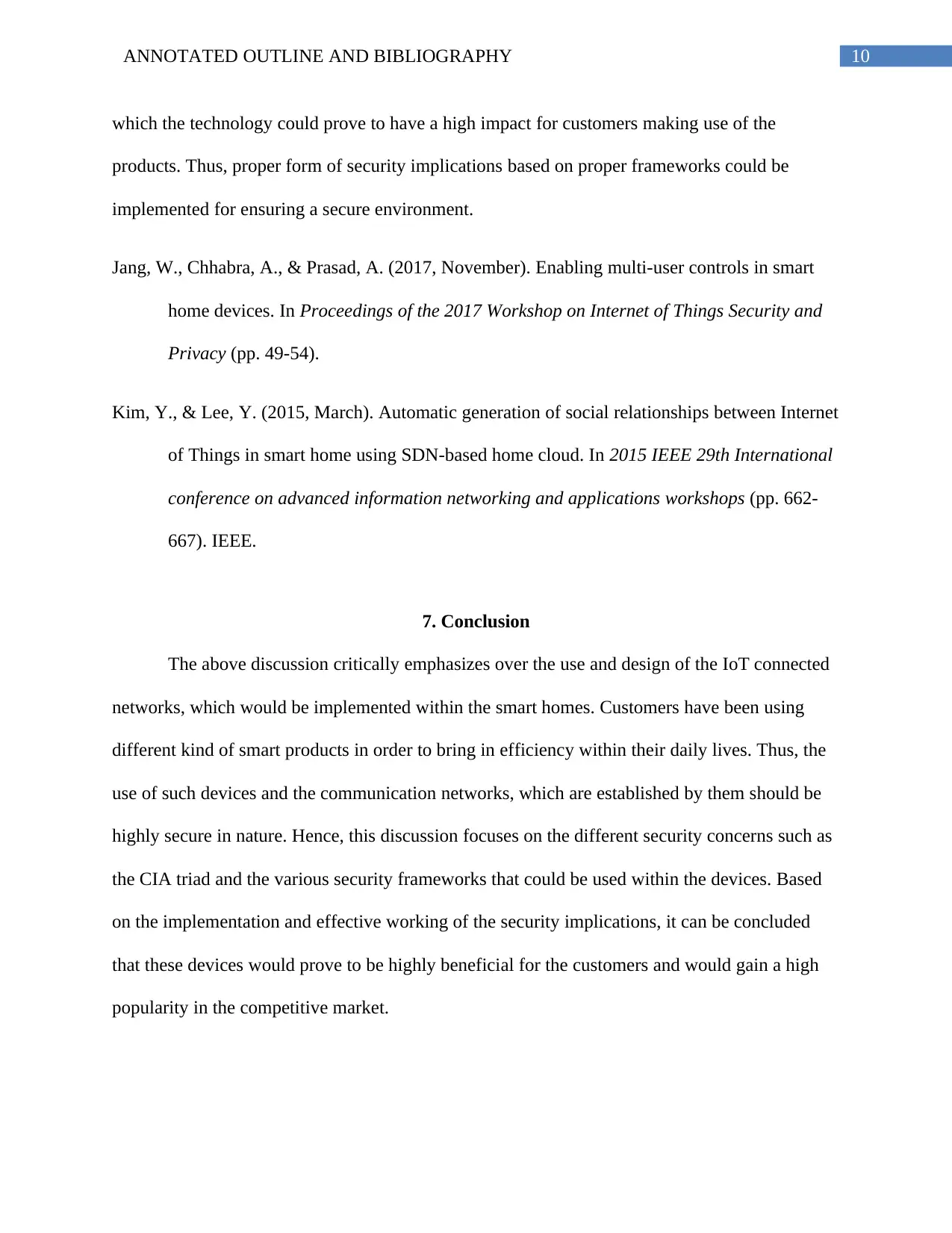
10ANNOTATED OUTLINE AND BIBLIOGRAPHY
which the technology could prove to have a high impact for customers making use of the
products. Thus, proper form of security implications based on proper frameworks could be
implemented for ensuring a secure environment.
Jang, W., Chhabra, A., & Prasad, A. (2017, November). Enabling multi-user controls in smart
home devices. In Proceedings of the 2017 Workshop on Internet of Things Security and
Privacy (pp. 49-54).
Kim, Y., & Lee, Y. (2015, March). Automatic generation of social relationships between Internet
of Things in smart home using SDN-based home cloud. In 2015 IEEE 29th International
conference on advanced information networking and applications workshops (pp. 662-
667). IEEE.
7. Conclusion
The above discussion critically emphasizes over the use and design of the IoT connected
networks, which would be implemented within the smart homes. Customers have been using
different kind of smart products in order to bring in efficiency within their daily lives. Thus, the
use of such devices and the communication networks, which are established by them should be
highly secure in nature. Hence, this discussion focuses on the different security concerns such as
the CIA triad and the various security frameworks that could be used within the devices. Based
on the implementation and effective working of the security implications, it can be concluded
that these devices would prove to be highly beneficial for the customers and would gain a high
popularity in the competitive market.
which the technology could prove to have a high impact for customers making use of the
products. Thus, proper form of security implications based on proper frameworks could be
implemented for ensuring a secure environment.
Jang, W., Chhabra, A., & Prasad, A. (2017, November). Enabling multi-user controls in smart
home devices. In Proceedings of the 2017 Workshop on Internet of Things Security and
Privacy (pp. 49-54).
Kim, Y., & Lee, Y. (2015, March). Automatic generation of social relationships between Internet
of Things in smart home using SDN-based home cloud. In 2015 IEEE 29th International
conference on advanced information networking and applications workshops (pp. 662-
667). IEEE.
7. Conclusion
The above discussion critically emphasizes over the use and design of the IoT connected
networks, which would be implemented within the smart homes. Customers have been using
different kind of smart products in order to bring in efficiency within their daily lives. Thus, the
use of such devices and the communication networks, which are established by them should be
highly secure in nature. Hence, this discussion focuses on the different security concerns such as
the CIA triad and the various security frameworks that could be used within the devices. Based
on the implementation and effective working of the security implications, it can be concluded
that these devices would prove to be highly beneficial for the customers and would gain a high
popularity in the competitive market.

11ANNOTATED OUTLINE AND BIBLIOGRAPHY
References
The proposed references for this paper are included in the annotated bibliography that follows
this annotated outline
References
The proposed references for this paper are included in the annotated bibliography that follows
this annotated outline
⊘ This is a preview!⊘
Do you want full access?
Subscribe today to unlock all pages.

Trusted by 1+ million students worldwide
1 out of 15